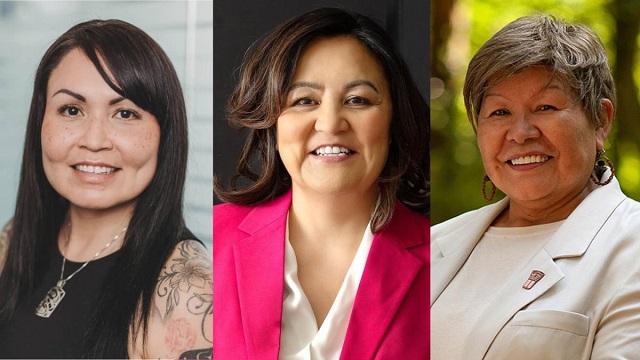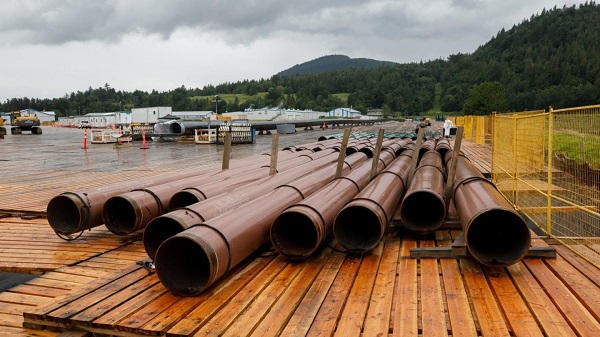Canadian Energy Centre
These three Indigenous women are leading the future of Canadian LNG

Crystal Smith, chief councillor of the Haisla Nation, Karen Ogen, CEO of the First Nations LNG Alliance, and Eva Clayton, president of the Nisga’a Nation.
From the Canadian Energy Centre
‘By being owners in these projects, we can meaningfully contribute to a cleaner and more just world’
Three female Indigenous leaders in British Columbia are leading the future of Canadian LNG.
Eva Clayton is president of the Nisga’a Nation, a joint venture partner in the proposed Ksi Lisims LNG project. Karen Ogen, former elected chief of the Wet’suwet’en First Nation, is CEO of the First Nations LNG Alliance. And Crystal Smith is elected chief of the Haisla Nation, majority owner of the proposed Cedar LNG project, which is in the final stages of preparing for the green light to proceed.
“By being owners in these projects, we can meaningfully contribute to a cleaner and more just world,” said Smith, who was first elected chief of the coastal nation in 2017, during the B.C. Natural Resources Forum earlier this year.
“From an Indigenous perspective, we’re continuously taught to take care of our environment, to take care of our land, and to take only what is required. To think in a global context, I truly believe that in supporting the LNG industry, we are in fact doing that.”

Eva Clayton, back left, President of the Nisga’a Lisims Government (joint venture owner of the proposed Ksi Lisims LNG project), Crystal Smith, back right, Haisla Nation Chief Councillor (joint venture owner of proposed Cedar LNG project), and Karen Ogen, front right, CEO of the First Nations LNG Alliance pose for a photograph on the HaiSea Wamis zero-emission tugboat outside the LNG2023 conference, in Vancouver, B.C., Monday, July 10, 2023. CP Images photo
The global liquefied natural gas industry is rising in importance as emerging economies in Asia look to move away from coal-fired power and European nations reduce reliance on Russia
In 2023, LNG demand reached a record 404 million tonnes, according to Shell’s latest industry outlook. Over the next two decades it is expected to rise by nearly 70 per cent, reaching 685 million tonnes by 2040.
Canada’s first LNG export terminal – located on Haisla territory – is nearing completion and preparing for startup next year.
Smith said the nation has seen great benefits from its support of the LNG Canada project, but owning Cedar LNG with partner Pembina Pipeline Corporation takes the opportunity to a new level.
“We have a bigger vision that provides better education, better health care, better justice, and a better future for our people,” she said.
“We can train our people with the skills needed to secure well-paying, family supporting jobs on Cedar LNG and other projects. We can build critical community infrastructure like our new health center and our youth center in Haisla territory.”
Smith said LNG is helping fund programs that reconnect Haisla people with their culture and language, “a language that virtually disappeared with my generation.”
“We are reigniting our potential through culture and language. And that is perhaps the most powerful thing of all. When I think of my daughter speaking Haisla with my grandchildren, that is what drives me each and every day.”
To the north in the Nass Valley, near B.C.’s border with Alaska, Clayton said the Nisga’a Nation is also using its partnerships in LNG to reconnect with language and culture.
The community owns Ksi Lisims along with Rockies LNG (a coalition of Canadian natural gas producers) and Texas-based developer Western LNG.

Construction of the LNG Canada export terminal is now more than 90 per cent complete. Photo courtesy LNG Canada
“The cultural benefits for the Nisga’a Nation will only be more enhanced as we move forward with the project,” said Clayton, who was first elected president of the community in 2016.
“There are ongoing programs that are in place so that our people and our young people will continue to speak the language. What I’ve noticed is that many of our elders that have been teaching this language are aging out. And so now we see a new generation of young people coming up to speak the language and teach language.”
In B.C.’s central interior, the Wet’suwet’en Nation is facing a loss of culture and language, Ogen said. It’s a situation that can be helped with the economic opportunities of LNG.
“We’re at a place in our community since the pandemic where we have maybe one or two fluent speakers left. That’s really not good news,” said Ogen, who served as chief from 2010 to 2016.
“We want to be able to promote our language in our community and continue promoting our culture in our community because we have very few people in my generation that have traditional names.”
Partnering in development projects like the recently completed Coastal GasLink pipeline (which will supply natural gas to the LNG Canada terminal as well as Cedar LNG) helps communities with access to clean drinking water, housing, health, wellness and education, Ogen said.
She helped found the First Nations LNG Alliance in 2015 with the goal to educate communities about the potential benefits of development.

As construction on Coastal GasLink winds down, crews are working to cleanup and reclaim the land. Clay and topsoil removed during construction has been stored on site and will now be used to contour the land to its previous shape to re-establish original drainage patterns. Photo courtesy Coastal GasLink
“I’ve learned a lot in this job. Being a girl from the rez, being a social worker, and then getting into this field, it’s something I didn’t aspire to. But for me, I’m passionate about it because of what it means to our people on the ground,” she said.
Ogen has shared that message internationally, including during a trade mission to China last fall. The smog from burning coal in Beijing heightened her conviction about the benefits of Canadian LNG in Asia, she said.
“We were given a presentation on how China still wants B.C.’s natural resources; they still want our LNG,” Ogen said.
“B.C. and Canada need to hear those loud messages because we’re at an economic opportunity that’ll help us address the greenhouse gas emissions globally.”
Clayton said she has heard the same thing.
“The messaging that I get from the international world is that they need our LNG. The Germans, Japanese, all of them are wondering why they’re not getting gas from their allies. We have a responsibility as Canadians to help the world get off of coal,” she said.
“We are working together for the benefit of our children. These major projects, every decision that we make is for the future of our children, the future of Canada, the world really when you think about the kind of industry we’re getting into, LNG.”
Smith’s Cedar LNG could be the first Indigenous-led project in the world. Pembina Pipeline plans to spend up to $300 million advancing it to a final investment decision by mid-year.
“Every time I hear about it, I literally start shaking and getting goosebumps. I’ll have many sleepless nights from now until that decision is made,” Smith said.
“Our nation has had the ability to benefit from LNG development in our territory, but let’s not let it be the last.
“There are so many other LNG projects with indigenous leadership in B.C. that have the potential to make a significant impact on the future of Indigenous people and also help fight climate change.”
Alberta
Alberta’s huge oil sands reserves dwarf U.S. shale

From the Canadian Energy Centre
By Will Gibson
Oil sands could maintain current production rates for more than 140 years
Investor interest in Canadian oil producers, primarily in the Alberta oil sands, has picked up, and not only because of expanded export capacity from the Trans Mountain pipeline.
Enverus Intelligence Research says the real draw — and a major factor behind oil sands equities outperforming U.S. peers by about 40 per cent since January 2024 — is the resource Trans Mountain helps unlock.
Alberta’s oil sands contain 167 billion barrels of reserves, nearly four times the volume in the United States.
Today’s oil sands operators hold more than twice the available high-quality resources compared to U.S. shale producers, Enverus reports.
“It’s a huge number — 167 billion barrels — when Alberta only produces about three million barrels a day right now,” said Mike Verney, executive vice-president at McDaniel & Associates, which earlier this year updated the province’s oil and gas reserves on behalf of the Alberta Energy Regulator.
Already fourth in the world, the assessment found Alberta’s oil reserves increased by seven billion barrels.
Verney said the rise in reserves despite record production is in part a result of improved processes and technology.
“Oil sands companies can produce for decades at the same economic threshold as they do today. That’s a great place to be,” said Michael Berger, a senior analyst with Enverus.
BMO Capital Markets estimates that Alberta’s oil sands reserves could maintain current production rates for more than 140 years.
The long-term picture looks different south of the border.
The U.S. Energy Information Administration projects that American production will peak before 2030 and enter a long period of decline.
Having a lasting stable source of supply is important as world oil demand is expected to remain strong for decades to come.
This is particularly true in Asia, the target market for oil exports off Canada’s West Coast.
The International Energy Agency (IEA) projects oil demand in the Asia-Pacific region will go from 35 million barrels per day in 2024 to 41 million barrels per day in 2050.
The growing appeal of Alberta oil in Asian markets shows up not only in expanded Trans Mountain shipments, but also in Canadian crude being “re-exported” from U.S. Gulf Coast terminals.
According to RBN Energy, Asian buyers – primarily in China – are now the main non-U.S. buyers from Trans Mountain, while India dominates purchases of re-exports from the U.S. Gulf Coast. .
BMO said the oil sands offers advantages both in steady supply and lower overall environmental impacts.
“Not only is the resulting stability ideally suited to backfill anticipated declines in world oil supply, but the long-term physical footprint may also be meaningfully lower given large-scale concentrated emissions, high water recycling rates and low well declines,” BMO analysts said.
Alberta
The case for expanding Canada’s energy exports

From the Canadian Energy Centre
For Canada, the path to a stronger economy — and stronger global influence — runs through energy.
That’s the view of David Detomasi, a professor at the Smith School of Business at Queen’s University.
Detomasi, author of Profits and Power: Navigating the Politics and Geopolitics of Oil, argues that there is a moral case for developing Canada’s energy, both for Canadians and the world.
CEC: What does being an energy superpower mean to you?
DD: It means Canada is strong enough to affect the system as a whole by its choices.
There is something really valuable about Canada’s — and Alberta’s — way of producing carbon energy that goes beyond just the monetary rewards.
CEC: You talk about the moral case for developing Canada’s energy. What do you mean?
DD: I think the default assumption in public rhetoric is that the environmental movement is the only voice speaking for the moral betterment of the world. That needs to be challenged.
That public rhetoric is that the act of cultivating a powerful, effective economic engine is somehow wrong or bad, and that efforts to create wealth are somehow morally tainted.
I think that’s dead wrong. Economic growth is morally good, and we should foster it.
Economic growth generates money, and you can’t do anything you want to do in social expenditures without that engine.
Economic growth is critical to doing all the other things we want to do as Canadians, like having a publicly funded health care system or providing transfer payments to less well-off provinces.
Over the last 10 years, many people in Canada came to equate moral leadership with getting off of oil and gas as quickly as possible. I think that is a mistake, and far too narrow.
Instead, I think moral leadership means you play that game, you play it well, and you do it in our interest, in the Canadian way.
We need a solid base of economic prosperity in this country first, and then we can help others.
CEC: Why is it important to expand Canada’s energy trade?
DD: Canada is, and has always been, a trading nation, because we’ve got a lot of geography and not that many people.
If we don’t trade what we have with the outside world, we aren’t going to be able to develop economically, because we don’t have the internal size and capacity.
Historically, most of that trade has been with the United States. Geography and history mean it will always be our primary trade partner.
But the United States clearly can be an unreliable partner. Free and open trade matters more to Canada than it does to the U.S. Indeed, a big chunk of the American people is skeptical of participating in a global trading system.
As the United States perhaps withdraws from the international trading and investment system, there’s room for Canada to reinforce it in places where we can use our resource advantages to build new, stronger relationships.
One of these is Europe, which still imports a lot of gas. We can also build positive relationships with the enormous emerging markets of China and India, both of whom want and will need enormous supplies of energy for many decades.
I would like to be able to offer partners the alternative option of buying Canadian energy so that they are less reliant on, say, Iranian or Russian energy.
Canada can also maybe eventually help the two billion people in the world currently without energy access.
CEC: What benefits could Canadians gain by becoming an energy superpower?
DD: The first and primary responsibility of our federal government is to look after Canada. At the end of the day, the goal is to improve Canada’s welfare and enhance its sovereignty.
More carbon energy development helps Canada. We have massive debt, an investment crisis and productivity problems that we’ve been talking about forever. Economic and job growth are weak.
Solving these will require profitable and productive industries. We don’t have so many economic strengths in this country that we can voluntarily ignore or constrain one of our biggest industries.
The economic benefits pay for things that make you stronger as a country.
They make you more resilient on the social welfare front and make increasing defence expenditures, which we sorely need, more affordable. It allows us to manage the debt that we’re running up, and supports deals for Canada’s Indigenous peoples.
CEC: Are there specific projects that you advocate for to make Canada an energy superpower?
DD: Canada’s energy needs egress, and getting it out to places other than the United States. That means more transport and port facilities to Canada’s coasts.
We also need domestic energy transport networks. People don’t know this, but a big chunk of Ontario’s oil supply runs through Michigan, posing a latent security risk to Ontario’s energy security.
We need to change the perception that pipelines are evil. There’s a spiderweb of them across the globe, and more are being built.
Building pipelines here, with Canadian technology and know-how, builds our competitiveness and enhances our sovereignty.
Economic growth enhances sovereignty and provides the resources to do other things. We should applaud and encourage it, and the carbon energy sector can lead the way.
-

 International22 hours ago
International22 hours agoOttawa is still dodging the China interference threat
-

 Business20 hours ago
Business20 hours agoThere’s No Bias at CBC News, You Say? Well, OK…
-

 Automotive19 hours ago
Automotive19 hours agoCanada’s EV gamble is starting to backfire
-

 International21 hours ago
International21 hours ago2025: The Year The Narrative Changed
-

 Fraser Institute2 days ago
Fraser Institute2 days agoCarney government sowing seeds for corruption in Ottawa
-

 Daily Caller2 days ago
Daily Caller2 days agoWhile Western Nations Cling to Energy Transition, Pragmatic Nations Produce Energy and Wealth
-

 Alberta2 days ago
Alberta2 days agoAlberta Next Panel calls for less Ottawa—and it could pay off
-

 Business1 day ago
Business1 day agoResidents in economically free states reap the rewards








